Case Study Assessment 2: Giovanni, Chronic Heart Failure, Nursing
VerifiedAdded on 2020/02/03
|13
|3718
|214
Case Study
AI Summary
This case study focuses on a 72-year-old patient, Giovanni, admitted to the emergency department with chronic heart failure, experiencing dyspnoea and a sense of suffocation. The report identifies two primary nursing problems: dyspnoea and chest pain (angina). For dyspnoea, interventions include diuretic therapy with ACE inhibitors and beta-blockers, along with dietary modifications (low salt, fat-free meals, small portions, semi-Fowler position). For angina, independent nursing involves Glyceryl trinitrate or Ivabradine, while collaborative interventions focus on lifestyle changes, including diet and smoking cessation. The case highlights the importance of tailored nursing care, including medication management, dietary adjustments, and lifestyle modifications to improve the patient's condition and prevent further complications like stroke or heart attack. The study emphasizes the role of healthcare professionals in managing chronic heart failure and angina through both independent and collaborative interventions. The patient's history of smoking, poor diet, and lack of exercise contribute to his condition, underscoring the need for comprehensive care.
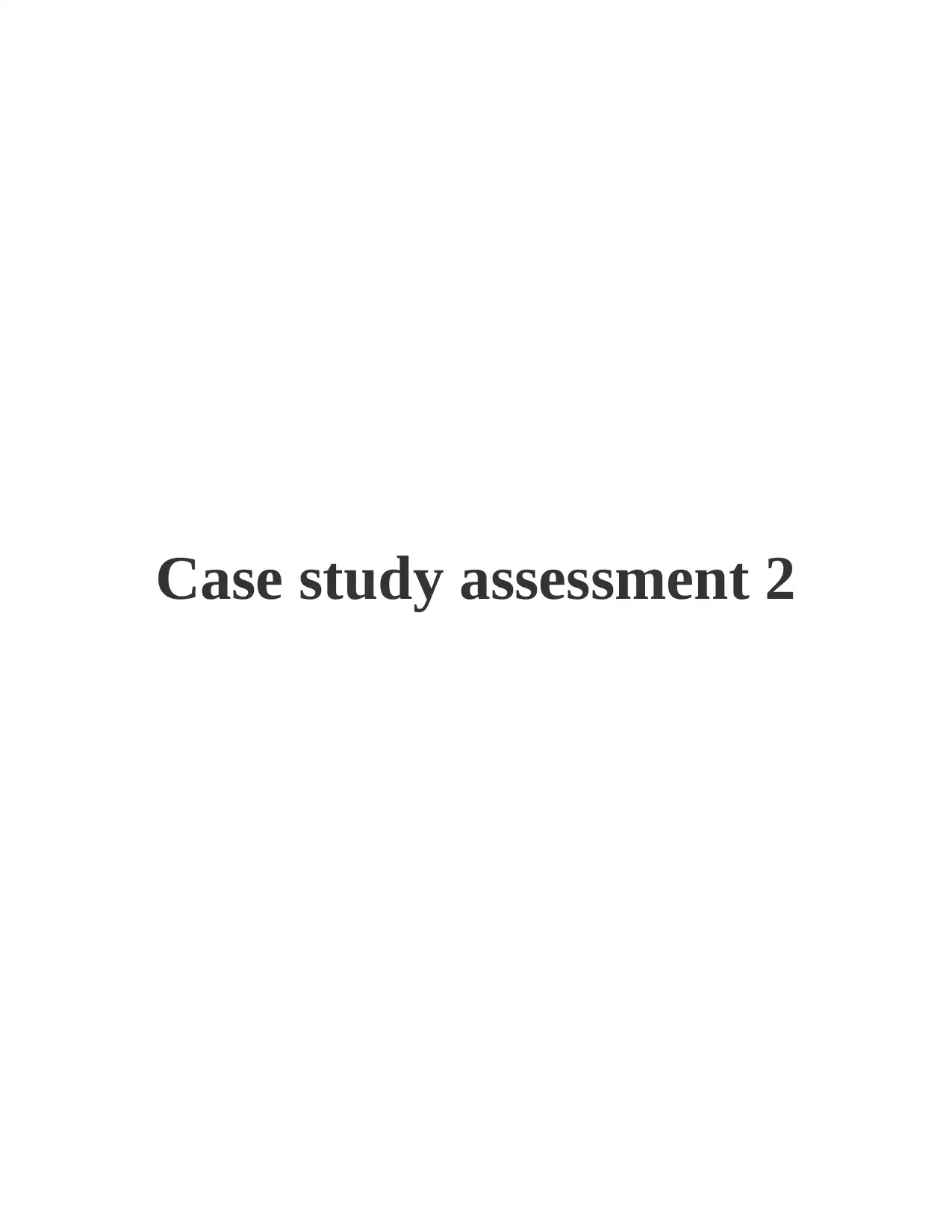
Case study assessment 2
Paraphrase This Document
Need a fresh take? Get an instant paraphrase of this document with our AI Paraphraser
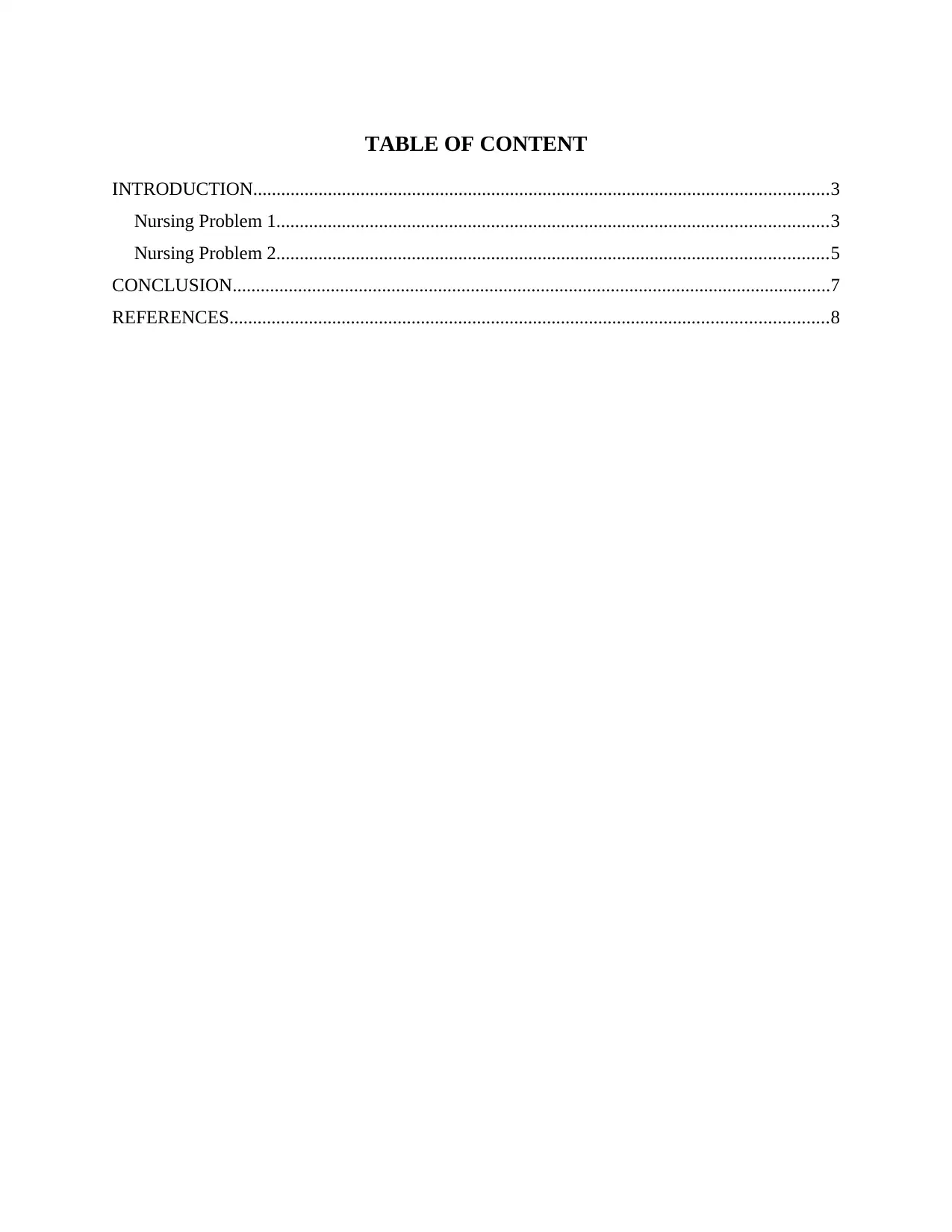
TABLE OF CONTENT
INTRODUCTION...........................................................................................................................3
Nursing Problem 1......................................................................................................................3
Nursing Problem 2......................................................................................................................5
CONCLUSION................................................................................................................................7
REFERENCES................................................................................................................................8
INTRODUCTION...........................................................................................................................3
Nursing Problem 1......................................................................................................................3
Nursing Problem 2......................................................................................................................5
CONCLUSION................................................................................................................................7
REFERENCES................................................................................................................................8
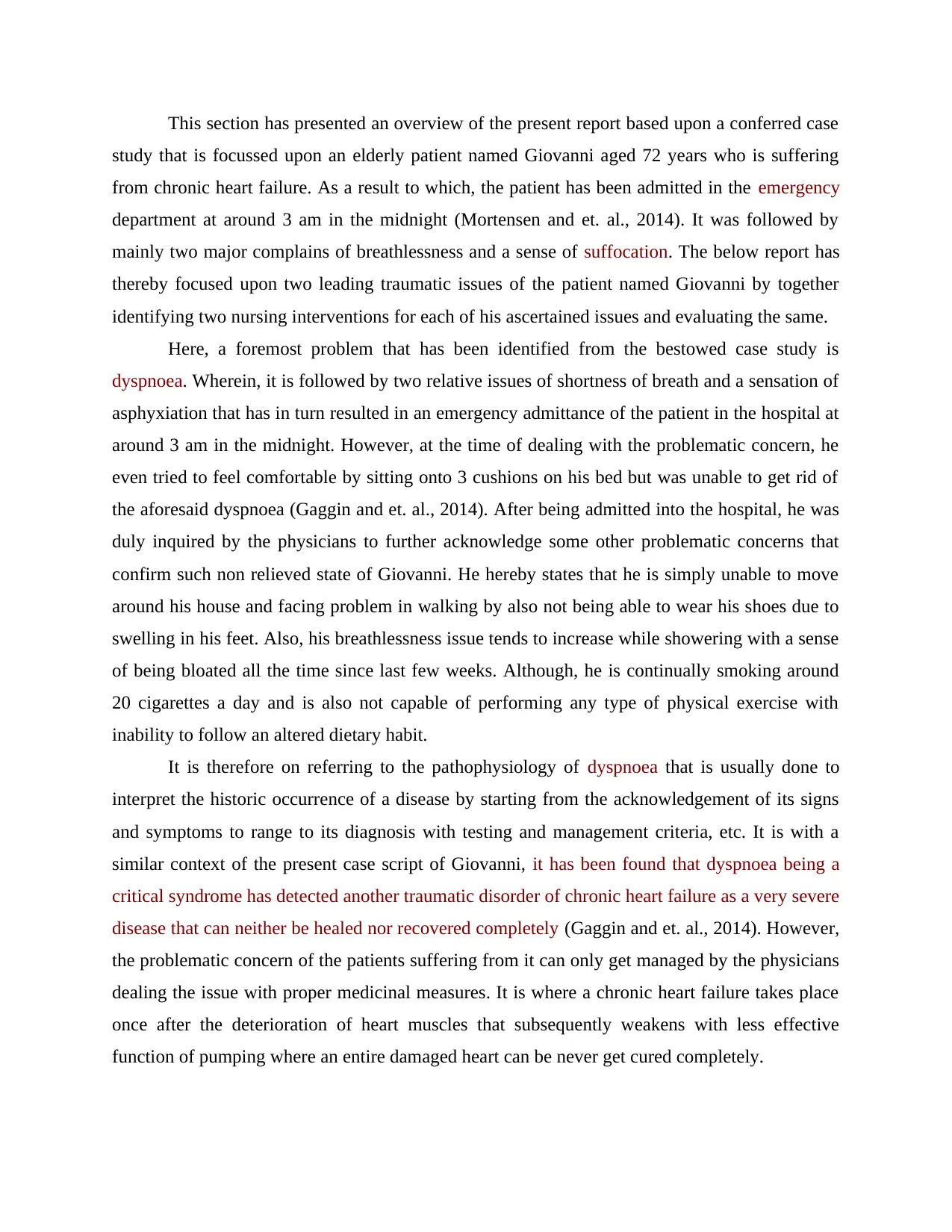
This section has presented an overview of the present report based upon a conferred case
study that is focussed upon an elderly patient named Giovanni aged 72 years who is suffering
from chronic heart failure. As a result to which, the patient has been admitted in the emergency
department at around 3 am in the midnight (Mortensen and et. al., 2014). It was followed by
mainly two major complains of breathlessness and a sense of suffocation. The below report has
thereby focused upon two leading traumatic issues of the patient named Giovanni by together
identifying two nursing interventions for each of his ascertained issues and evaluating the same.
Here, a foremost problem that has been identified from the bestowed case study is
dyspnoea. Wherein, it is followed by two relative issues of shortness of breath and a sensation of
asphyxiation that has in turn resulted in an emergency admittance of the patient in the hospital at
around 3 am in the midnight. However, at the time of dealing with the problematic concern, he
even tried to feel comfortable by sitting onto 3 cushions on his bed but was unable to get rid of
the aforesaid dyspnoea (Gaggin and et. al., 2014). After being admitted into the hospital, he was
duly inquired by the physicians to further acknowledge some other problematic concerns that
confirm such non relieved state of Giovanni. He hereby states that he is simply unable to move
around his house and facing problem in walking by also not being able to wear his shoes due to
swelling in his feet. Also, his breathlessness issue tends to increase while showering with a sense
of being bloated all the time since last few weeks. Although, he is continually smoking around
20 cigarettes a day and is also not capable of performing any type of physical exercise with
inability to follow an altered dietary habit.
It is therefore on referring to the pathophysiology of dyspnoea that is usually done to
interpret the historic occurrence of a disease by starting from the acknowledgement of its signs
and symptoms to range to its diagnosis with testing and management criteria, etc. It is with a
similar context of the present case script of Giovanni, it has been found that dyspnoea being a
critical syndrome has detected another traumatic disorder of chronic heart failure as a very severe
disease that can neither be healed nor recovered completely (Gaggin and et. al., 2014). However,
the problematic concern of the patients suffering from it can only get managed by the physicians
dealing the issue with proper medicinal measures. It is where a chronic heart failure takes place
once after the deterioration of heart muscles that subsequently weakens with less effective
function of pumping where an entire damaged heart can be never get cured completely.
study that is focussed upon an elderly patient named Giovanni aged 72 years who is suffering
from chronic heart failure. As a result to which, the patient has been admitted in the emergency
department at around 3 am in the midnight (Mortensen and et. al., 2014). It was followed by
mainly two major complains of breathlessness and a sense of suffocation. The below report has
thereby focused upon two leading traumatic issues of the patient named Giovanni by together
identifying two nursing interventions for each of his ascertained issues and evaluating the same.
Here, a foremost problem that has been identified from the bestowed case study is
dyspnoea. Wherein, it is followed by two relative issues of shortness of breath and a sensation of
asphyxiation that has in turn resulted in an emergency admittance of the patient in the hospital at
around 3 am in the midnight. However, at the time of dealing with the problematic concern, he
even tried to feel comfortable by sitting onto 3 cushions on his bed but was unable to get rid of
the aforesaid dyspnoea (Gaggin and et. al., 2014). After being admitted into the hospital, he was
duly inquired by the physicians to further acknowledge some other problematic concerns that
confirm such non relieved state of Giovanni. He hereby states that he is simply unable to move
around his house and facing problem in walking by also not being able to wear his shoes due to
swelling in his feet. Also, his breathlessness issue tends to increase while showering with a sense
of being bloated all the time since last few weeks. Although, he is continually smoking around
20 cigarettes a day and is also not capable of performing any type of physical exercise with
inability to follow an altered dietary habit.
It is therefore on referring to the pathophysiology of dyspnoea that is usually done to
interpret the historic occurrence of a disease by starting from the acknowledgement of its signs
and symptoms to range to its diagnosis with testing and management criteria, etc. It is with a
similar context of the present case script of Giovanni, it has been found that dyspnoea being a
critical syndrome has detected another traumatic disorder of chronic heart failure as a very severe
disease that can neither be healed nor recovered completely (Gaggin and et. al., 2014). However,
the problematic concern of the patients suffering from it can only get managed by the physicians
dealing the issue with proper medicinal measures. It is where a chronic heart failure takes place
once after the deterioration of heart muscles that subsequently weakens with less effective
function of pumping where an entire damaged heart can be never get cured completely.
⊘ This is a preview!⊘
Do you want full access?
Subscribe today to unlock all pages.

Trusted by 1+ million students worldwide
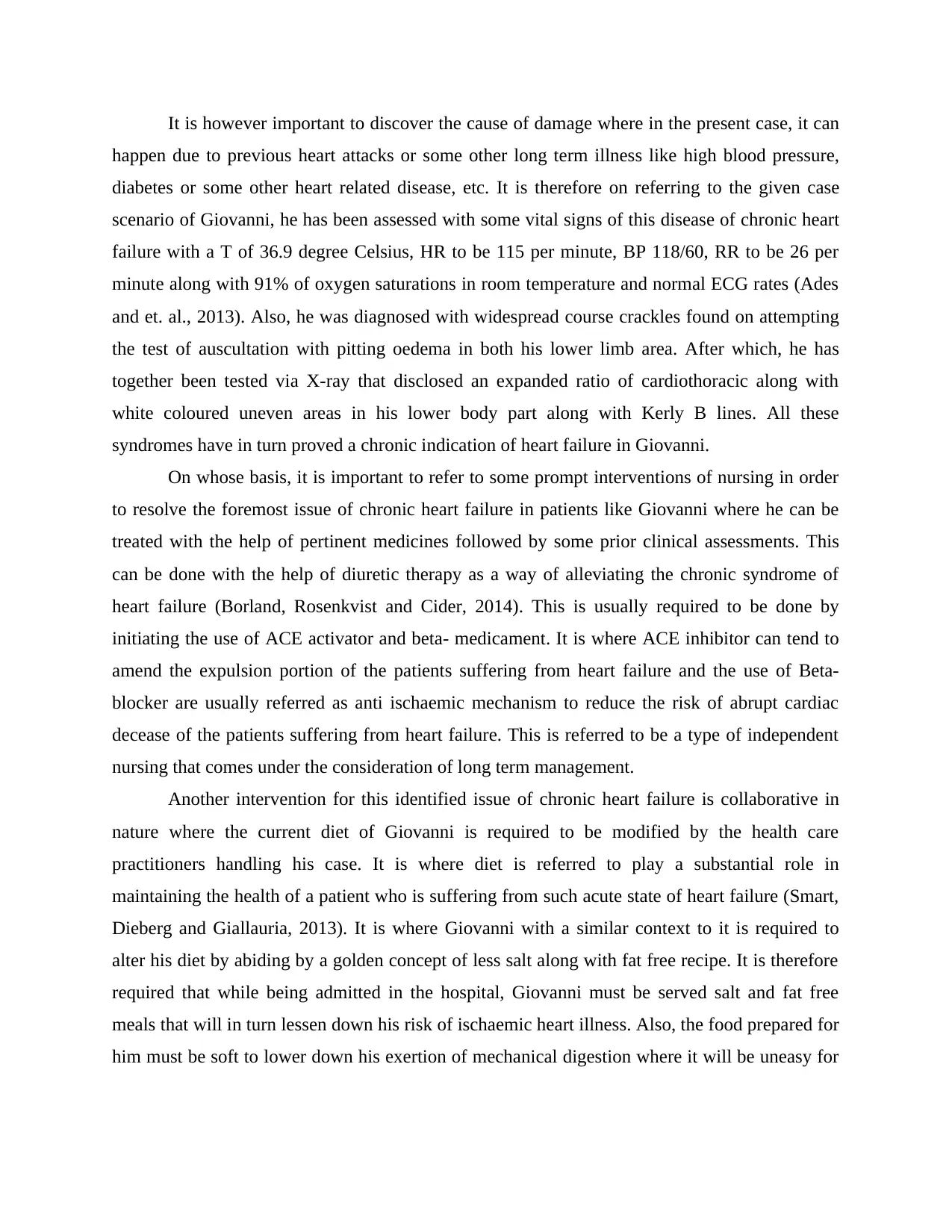
It is however important to discover the cause of damage where in the present case, it can
happen due to previous heart attacks or some other long term illness like high blood pressure,
diabetes or some other heart related disease, etc. It is therefore on referring to the given case
scenario of Giovanni, he has been assessed with some vital signs of this disease of chronic heart
failure with a T of 36.9 degree Celsius, HR to be 115 per minute, BP 118/60, RR to be 26 per
minute along with 91% of oxygen saturations in room temperature and normal ECG rates (Ades
and et. al., 2013). Also, he was diagnosed with widespread course crackles found on attempting
the test of auscultation with pitting oedema in both his lower limb area. After which, he has
together been tested via X-ray that disclosed an expanded ratio of cardiothoracic along with
white coloured uneven areas in his lower body part along with Kerly B lines. All these
syndromes have in turn proved a chronic indication of heart failure in Giovanni.
On whose basis, it is important to refer to some prompt interventions of nursing in order
to resolve the foremost issue of chronic heart failure in patients like Giovanni where he can be
treated with the help of pertinent medicines followed by some prior clinical assessments. This
can be done with the help of diuretic therapy as a way of alleviating the chronic syndrome of
heart failure (Borland, Rosenkvist and Cider, 2014). This is usually required to be done by
initiating the use of ACE activator and beta- medicament. It is where ACE inhibitor can tend to
amend the expulsion portion of the patients suffering from heart failure and the use of Beta-
blocker are usually referred as anti ischaemic mechanism to reduce the risk of abrupt cardiac
decease of the patients suffering from heart failure. This is referred to be a type of independent
nursing that comes under the consideration of long term management.
Another intervention for this identified issue of chronic heart failure is collaborative in
nature where the current diet of Giovanni is required to be modified by the health care
practitioners handling his case. It is where diet is referred to play a substantial role in
maintaining the health of a patient who is suffering from such acute state of heart failure (Smart,
Dieberg and Giallauria, 2013). It is where Giovanni with a similar context to it is required to
alter his diet by abiding by a golden concept of less salt along with fat free recipe. It is therefore
required that while being admitted in the hospital, Giovanni must be served salt and fat free
meals that will in turn lessen down his risk of ischaemic heart illness. Also, the food prepared for
him must be soft to lower down his exertion of mechanical digestion where it will be uneasy for
happen due to previous heart attacks or some other long term illness like high blood pressure,
diabetes or some other heart related disease, etc. It is therefore on referring to the given case
scenario of Giovanni, he has been assessed with some vital signs of this disease of chronic heart
failure with a T of 36.9 degree Celsius, HR to be 115 per minute, BP 118/60, RR to be 26 per
minute along with 91% of oxygen saturations in room temperature and normal ECG rates (Ades
and et. al., 2013). Also, he was diagnosed with widespread course crackles found on attempting
the test of auscultation with pitting oedema in both his lower limb area. After which, he has
together been tested via X-ray that disclosed an expanded ratio of cardiothoracic along with
white coloured uneven areas in his lower body part along with Kerly B lines. All these
syndromes have in turn proved a chronic indication of heart failure in Giovanni.
On whose basis, it is important to refer to some prompt interventions of nursing in order
to resolve the foremost issue of chronic heart failure in patients like Giovanni where he can be
treated with the help of pertinent medicines followed by some prior clinical assessments. This
can be done with the help of diuretic therapy as a way of alleviating the chronic syndrome of
heart failure (Borland, Rosenkvist and Cider, 2014). This is usually required to be done by
initiating the use of ACE activator and beta- medicament. It is where ACE inhibitor can tend to
amend the expulsion portion of the patients suffering from heart failure and the use of Beta-
blocker are usually referred as anti ischaemic mechanism to reduce the risk of abrupt cardiac
decease of the patients suffering from heart failure. This is referred to be a type of independent
nursing that comes under the consideration of long term management.
Another intervention for this identified issue of chronic heart failure is collaborative in
nature where the current diet of Giovanni is required to be modified by the health care
practitioners handling his case. It is where diet is referred to play a substantial role in
maintaining the health of a patient who is suffering from such acute state of heart failure (Smart,
Dieberg and Giallauria, 2013). It is where Giovanni with a similar context to it is required to
alter his diet by abiding by a golden concept of less salt along with fat free recipe. It is therefore
required that while being admitted in the hospital, Giovanni must be served salt and fat free
meals that will in turn lessen down his risk of ischaemic heart illness. Also, the food prepared for
him must be soft to lower down his exertion of mechanical digestion where it will be uneasy for
Paraphrase This Document
Need a fresh take? Get an instant paraphrase of this document with our AI Paraphraser
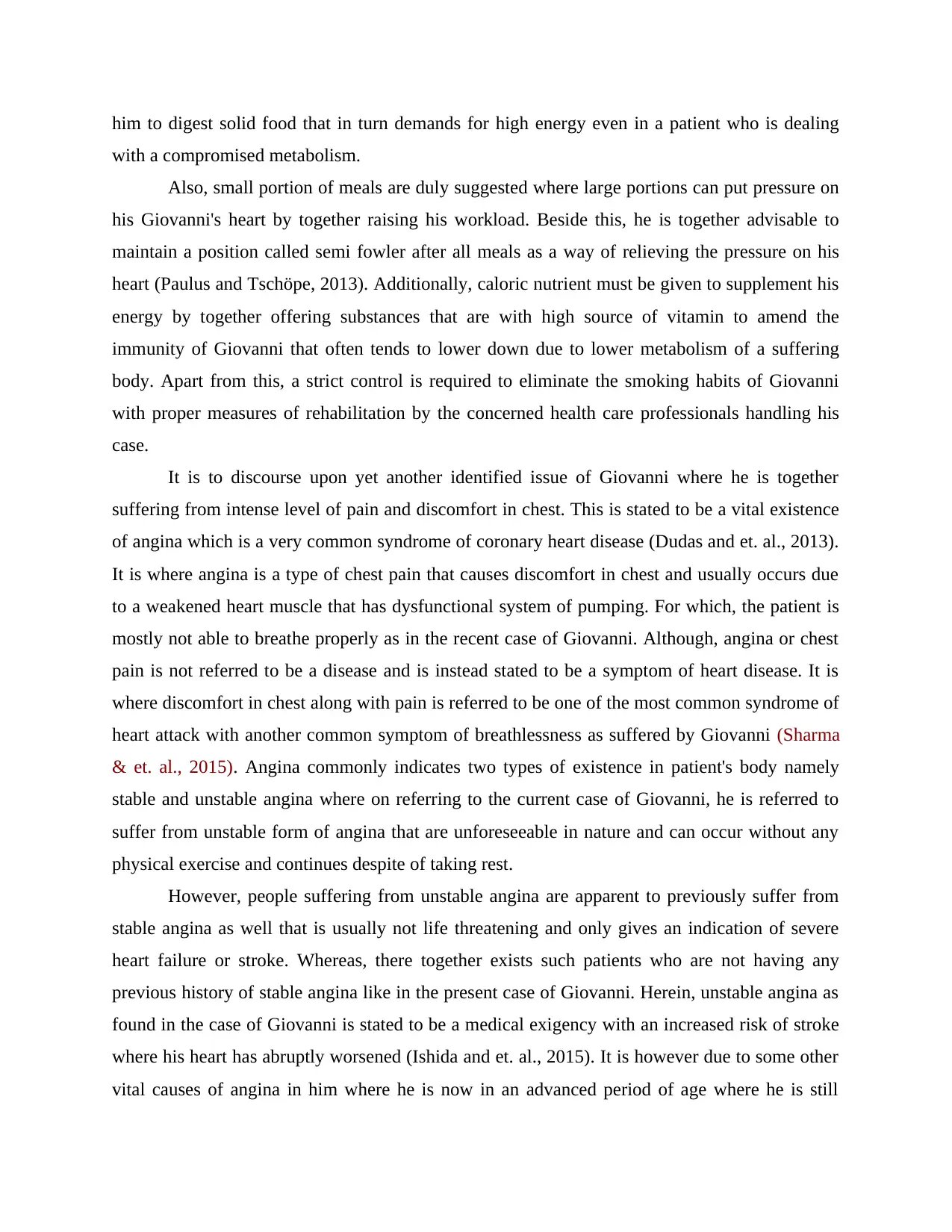
him to digest solid food that in turn demands for high energy even in a patient who is dealing
with a compromised metabolism.
Also, small portion of meals are duly suggested where large portions can put pressure on
his Giovanni's heart by together raising his workload. Beside this, he is together advisable to
maintain a position called semi fowler after all meals as a way of relieving the pressure on his
heart (Paulus and Tschöpe, 2013). Additionally, caloric nutrient must be given to supplement his
energy by together offering substances that are with high source of vitamin to amend the
immunity of Giovanni that often tends to lower down due to lower metabolism of a suffering
body. Apart from this, a strict control is required to eliminate the smoking habits of Giovanni
with proper measures of rehabilitation by the concerned health care professionals handling his
case.
It is to discourse upon yet another identified issue of Giovanni where he is together
suffering from intense level of pain and discomfort in chest. This is stated to be a vital existence
of angina which is a very common syndrome of coronary heart disease (Dudas and et. al., 2013).
It is where angina is a type of chest pain that causes discomfort in chest and usually occurs due
to a weakened heart muscle that has dysfunctional system of pumping. For which, the patient is
mostly not able to breathe properly as in the recent case of Giovanni. Although, angina or chest
pain is not referred to be a disease and is instead stated to be a symptom of heart disease. It is
where discomfort in chest along with pain is referred to be one of the most common syndrome of
heart attack with another common symptom of breathlessness as suffered by Giovanni (Sharma
& et. al., 2015). Angina commonly indicates two types of existence in patient's body namely
stable and unstable angina where on referring to the current case of Giovanni, he is referred to
suffer from unstable form of angina that are unforeseeable in nature and can occur without any
physical exercise and continues despite of taking rest.
However, people suffering from unstable angina are apparent to previously suffer from
stable angina as well that is usually not life threatening and only gives an indication of severe
heart failure or stroke. Whereas, there together exists such patients who are not having any
previous history of stable angina like in the present case of Giovanni. Herein, unstable angina as
found in the case of Giovanni is stated to be a medical exigency with an increased risk of stroke
where his heart has abruptly worsened (Ishida and et. al., 2015). It is however due to some other
vital causes of angina in him where he is now in an advanced period of age where he is still
with a compromised metabolism.
Also, small portion of meals are duly suggested where large portions can put pressure on
his Giovanni's heart by together raising his workload. Beside this, he is together advisable to
maintain a position called semi fowler after all meals as a way of relieving the pressure on his
heart (Paulus and Tschöpe, 2013). Additionally, caloric nutrient must be given to supplement his
energy by together offering substances that are with high source of vitamin to amend the
immunity of Giovanni that often tends to lower down due to lower metabolism of a suffering
body. Apart from this, a strict control is required to eliminate the smoking habits of Giovanni
with proper measures of rehabilitation by the concerned health care professionals handling his
case.
It is to discourse upon yet another identified issue of Giovanni where he is together
suffering from intense level of pain and discomfort in chest. This is stated to be a vital existence
of angina which is a very common syndrome of coronary heart disease (Dudas and et. al., 2013).
It is where angina is a type of chest pain that causes discomfort in chest and usually occurs due
to a weakened heart muscle that has dysfunctional system of pumping. For which, the patient is
mostly not able to breathe properly as in the recent case of Giovanni. Although, angina or chest
pain is not referred to be a disease and is instead stated to be a symptom of heart disease. It is
where discomfort in chest along with pain is referred to be one of the most common syndrome of
heart attack with another common symptom of breathlessness as suffered by Giovanni (Sharma
& et. al., 2015). Angina commonly indicates two types of existence in patient's body namely
stable and unstable angina where on referring to the current case of Giovanni, he is referred to
suffer from unstable form of angina that are unforeseeable in nature and can occur without any
physical exercise and continues despite of taking rest.
However, people suffering from unstable angina are apparent to previously suffer from
stable angina as well that is usually not life threatening and only gives an indication of severe
heart failure or stroke. Whereas, there together exists such patients who are not having any
previous history of stable angina like in the present case of Giovanni. Herein, unstable angina as
found in the case of Giovanni is stated to be a medical exigency with an increased risk of stroke
where his heart has abruptly worsened (Ishida and et. al., 2015). It is however due to some other
vital causes of angina in him where he is now in an advanced period of age where he is still
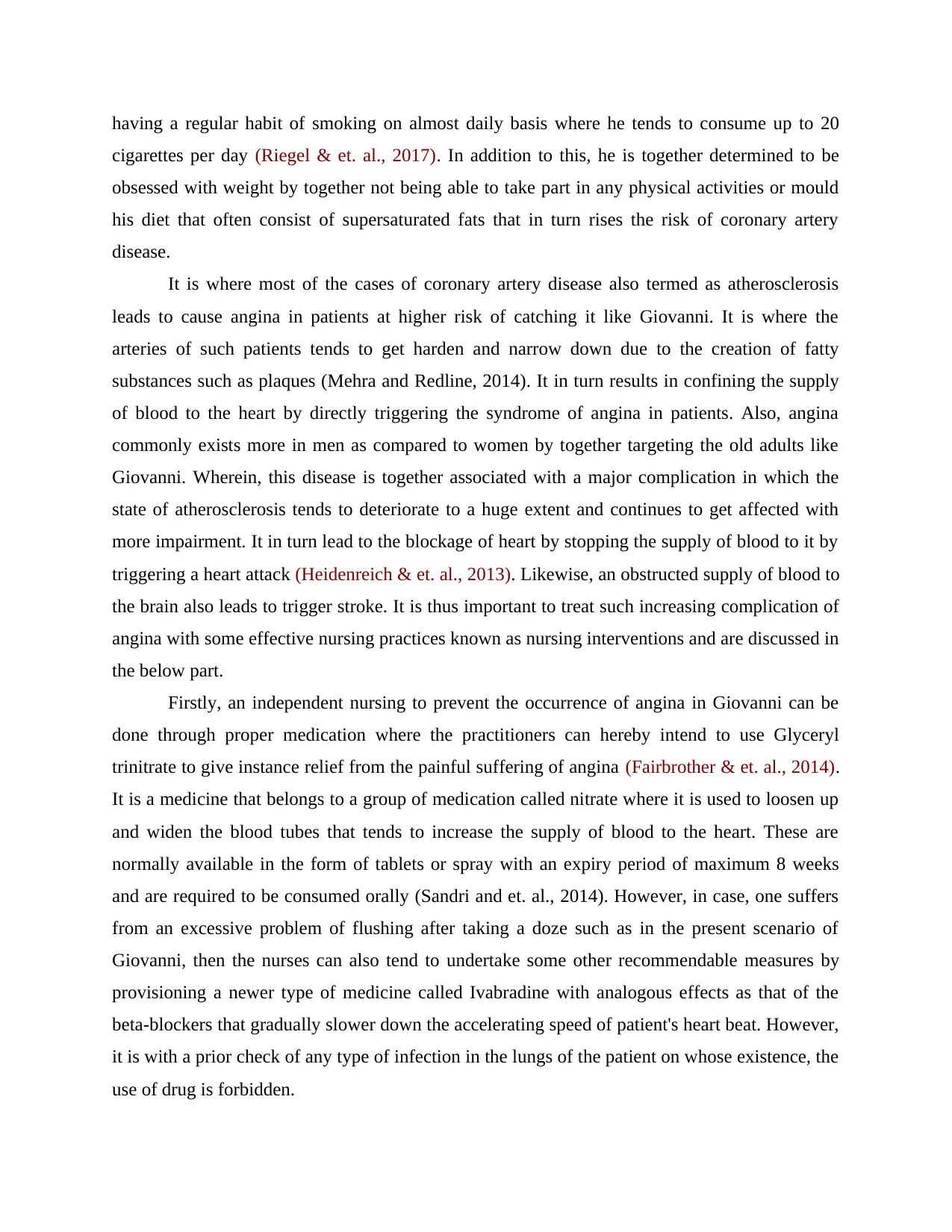
having a regular habit of smoking on almost daily basis where he tends to consume up to 20
cigarettes per day (Riegel & et. al., 2017). In addition to this, he is together determined to be
obsessed with weight by together not being able to take part in any physical activities or mould
his diet that often consist of supersaturated fats that in turn rises the risk of coronary artery
disease.
It is where most of the cases of coronary artery disease also termed as atherosclerosis
leads to cause angina in patients at higher risk of catching it like Giovanni. It is where the
arteries of such patients tends to get harden and narrow down due to the creation of fatty
substances such as plaques (Mehra and Redline, 2014). It in turn results in confining the supply
of blood to the heart by directly triggering the syndrome of angina in patients. Also, angina
commonly exists more in men as compared to women by together targeting the old adults like
Giovanni. Wherein, this disease is together associated with a major complication in which the
state of atherosclerosis tends to deteriorate to a huge extent and continues to get affected with
more impairment. It in turn lead to the blockage of heart by stopping the supply of blood to it by
triggering a heart attack (Heidenreich & et. al., 2013). Likewise, an obstructed supply of blood to
the brain also leads to trigger stroke. It is thus important to treat such increasing complication of
angina with some effective nursing practices known as nursing interventions and are discussed in
the below part.
Firstly, an independent nursing to prevent the occurrence of angina in Giovanni can be
done through proper medication where the practitioners can hereby intend to use Glyceryl
trinitrate to give instance relief from the painful suffering of angina (Fairbrother & et. al., 2014).
It is a medicine that belongs to a group of medication called nitrate where it is used to loosen up
and widen the blood tubes that tends to increase the supply of blood to the heart. These are
normally available in the form of tablets or spray with an expiry period of maximum 8 weeks
and are required to be consumed orally (Sandri and et. al., 2014). However, in case, one suffers
from an excessive problem of flushing after taking a doze such as in the present scenario of
Giovanni, then the nurses can also tend to undertake some other recommendable measures by
provisioning a newer type of medicine called Ivabradine with analogous effects as that of the
beta-blockers that gradually slower down the accelerating speed of patient's heart beat. However,
it is with a prior check of any type of infection in the lungs of the patient on whose existence, the
use of drug is forbidden.
cigarettes per day (Riegel & et. al., 2017). In addition to this, he is together determined to be
obsessed with weight by together not being able to take part in any physical activities or mould
his diet that often consist of supersaturated fats that in turn rises the risk of coronary artery
disease.
It is where most of the cases of coronary artery disease also termed as atherosclerosis
leads to cause angina in patients at higher risk of catching it like Giovanni. It is where the
arteries of such patients tends to get harden and narrow down due to the creation of fatty
substances such as plaques (Mehra and Redline, 2014). It in turn results in confining the supply
of blood to the heart by directly triggering the syndrome of angina in patients. Also, angina
commonly exists more in men as compared to women by together targeting the old adults like
Giovanni. Wherein, this disease is together associated with a major complication in which the
state of atherosclerosis tends to deteriorate to a huge extent and continues to get affected with
more impairment. It in turn lead to the blockage of heart by stopping the supply of blood to it by
triggering a heart attack (Heidenreich & et. al., 2013). Likewise, an obstructed supply of blood to
the brain also leads to trigger stroke. It is thus important to treat such increasing complication of
angina with some effective nursing practices known as nursing interventions and are discussed in
the below part.
Firstly, an independent nursing to prevent the occurrence of angina in Giovanni can be
done through proper medication where the practitioners can hereby intend to use Glyceryl
trinitrate to give instance relief from the painful suffering of angina (Fairbrother & et. al., 2014).
It is a medicine that belongs to a group of medication called nitrate where it is used to loosen up
and widen the blood tubes that tends to increase the supply of blood to the heart. These are
normally available in the form of tablets or spray with an expiry period of maximum 8 weeks
and are required to be consumed orally (Sandri and et. al., 2014). However, in case, one suffers
from an excessive problem of flushing after taking a doze such as in the present scenario of
Giovanni, then the nurses can also tend to undertake some other recommendable measures by
provisioning a newer type of medicine called Ivabradine with analogous effects as that of the
beta-blockers that gradually slower down the accelerating speed of patient's heart beat. However,
it is with a prior check of any type of infection in the lungs of the patient on whose existence, the
use of drug is forbidden.
⊘ This is a preview!⊘
Do you want full access?
Subscribe today to unlock all pages.

Trusted by 1+ million students worldwide
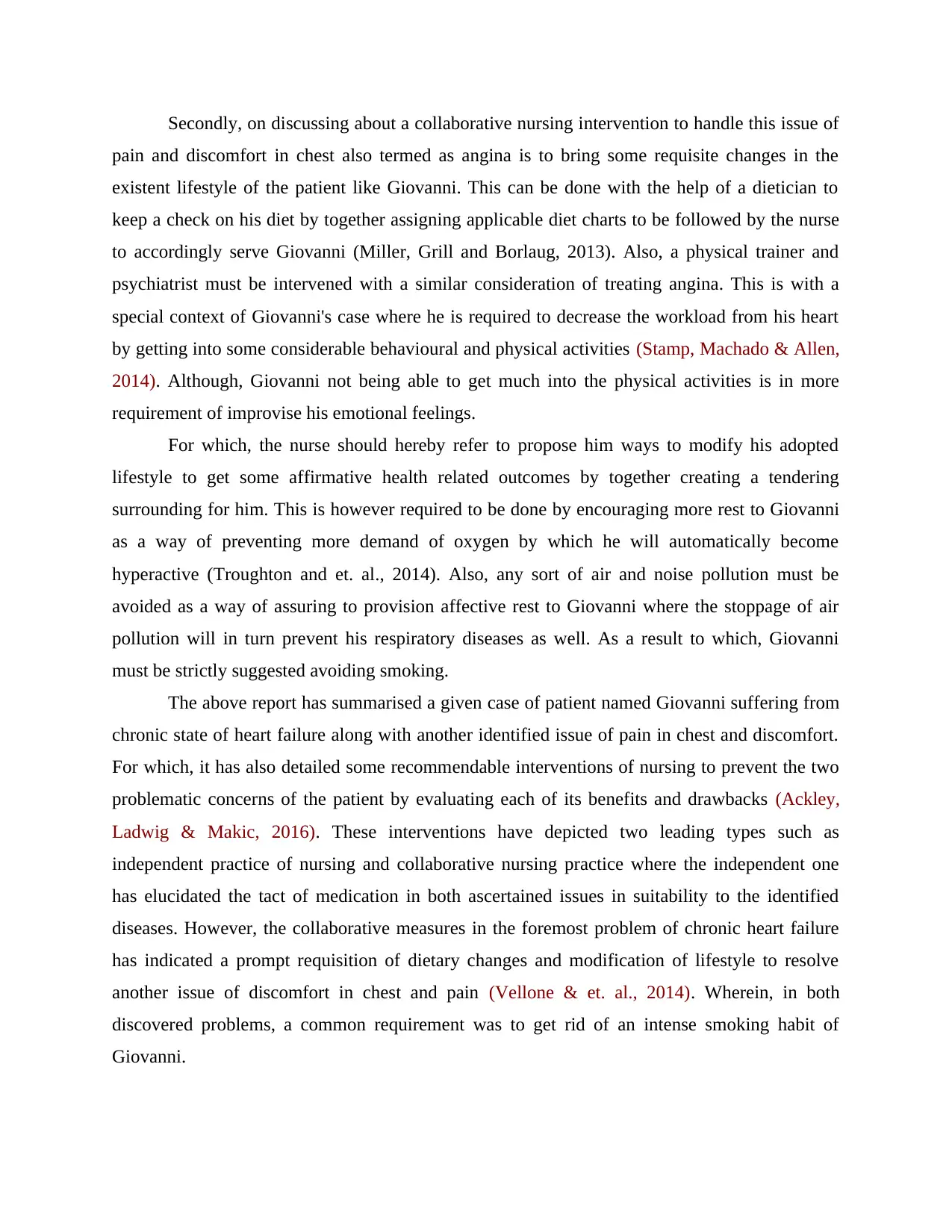
Secondly, on discussing about a collaborative nursing intervention to handle this issue of
pain and discomfort in chest also termed as angina is to bring some requisite changes in the
existent lifestyle of the patient like Giovanni. This can be done with the help of a dietician to
keep a check on his diet by together assigning applicable diet charts to be followed by the nurse
to accordingly serve Giovanni (Miller, Grill and Borlaug, 2013). Also, a physical trainer and
psychiatrist must be intervened with a similar consideration of treating angina. This is with a
special context of Giovanni's case where he is required to decrease the workload from his heart
by getting into some considerable behavioural and physical activities (Stamp, Machado & Allen,
2014). Although, Giovanni not being able to get much into the physical activities is in more
requirement of improvise his emotional feelings.
For which, the nurse should hereby refer to propose him ways to modify his adopted
lifestyle to get some affirmative health related outcomes by together creating a tendering
surrounding for him. This is however required to be done by encouraging more rest to Giovanni
as a way of preventing more demand of oxygen by which he will automatically become
hyperactive (Troughton and et. al., 2014). Also, any sort of air and noise pollution must be
avoided as a way of assuring to provision affective rest to Giovanni where the stoppage of air
pollution will in turn prevent his respiratory diseases as well. As a result to which, Giovanni
must be strictly suggested avoiding smoking.
The above report has summarised a given case of patient named Giovanni suffering from
chronic state of heart failure along with another identified issue of pain in chest and discomfort.
For which, it has also detailed some recommendable interventions of nursing to prevent the two
problematic concerns of the patient by evaluating each of its benefits and drawbacks (Ackley,
Ladwig & Makic, 2016). These interventions have depicted two leading types such as
independent practice of nursing and collaborative nursing practice where the independent one
has elucidated the tact of medication in both ascertained issues in suitability to the identified
diseases. However, the collaborative measures in the foremost problem of chronic heart failure
has indicated a prompt requisition of dietary changes and modification of lifestyle to resolve
another issue of discomfort in chest and pain (Vellone & et. al., 2014). Wherein, in both
discovered problems, a common requirement was to get rid of an intense smoking habit of
Giovanni.
pain and discomfort in chest also termed as angina is to bring some requisite changes in the
existent lifestyle of the patient like Giovanni. This can be done with the help of a dietician to
keep a check on his diet by together assigning applicable diet charts to be followed by the nurse
to accordingly serve Giovanni (Miller, Grill and Borlaug, 2013). Also, a physical trainer and
psychiatrist must be intervened with a similar consideration of treating angina. This is with a
special context of Giovanni's case where he is required to decrease the workload from his heart
by getting into some considerable behavioural and physical activities (Stamp, Machado & Allen,
2014). Although, Giovanni not being able to get much into the physical activities is in more
requirement of improvise his emotional feelings.
For which, the nurse should hereby refer to propose him ways to modify his adopted
lifestyle to get some affirmative health related outcomes by together creating a tendering
surrounding for him. This is however required to be done by encouraging more rest to Giovanni
as a way of preventing more demand of oxygen by which he will automatically become
hyperactive (Troughton and et. al., 2014). Also, any sort of air and noise pollution must be
avoided as a way of assuring to provision affective rest to Giovanni where the stoppage of air
pollution will in turn prevent his respiratory diseases as well. As a result to which, Giovanni
must be strictly suggested avoiding smoking.
The above report has summarised a given case of patient named Giovanni suffering from
chronic state of heart failure along with another identified issue of pain in chest and discomfort.
For which, it has also detailed some recommendable interventions of nursing to prevent the two
problematic concerns of the patient by evaluating each of its benefits and drawbacks (Ackley,
Ladwig & Makic, 2016). These interventions have depicted two leading types such as
independent practice of nursing and collaborative nursing practice where the independent one
has elucidated the tact of medication in both ascertained issues in suitability to the identified
diseases. However, the collaborative measures in the foremost problem of chronic heart failure
has indicated a prompt requisition of dietary changes and modification of lifestyle to resolve
another issue of discomfort in chest and pain (Vellone & et. al., 2014). Wherein, in both
discovered problems, a common requirement was to get rid of an intense smoking habit of
Giovanni.
Paraphrase This Document
Need a fresh take? Get an instant paraphrase of this document with our AI Paraphraser
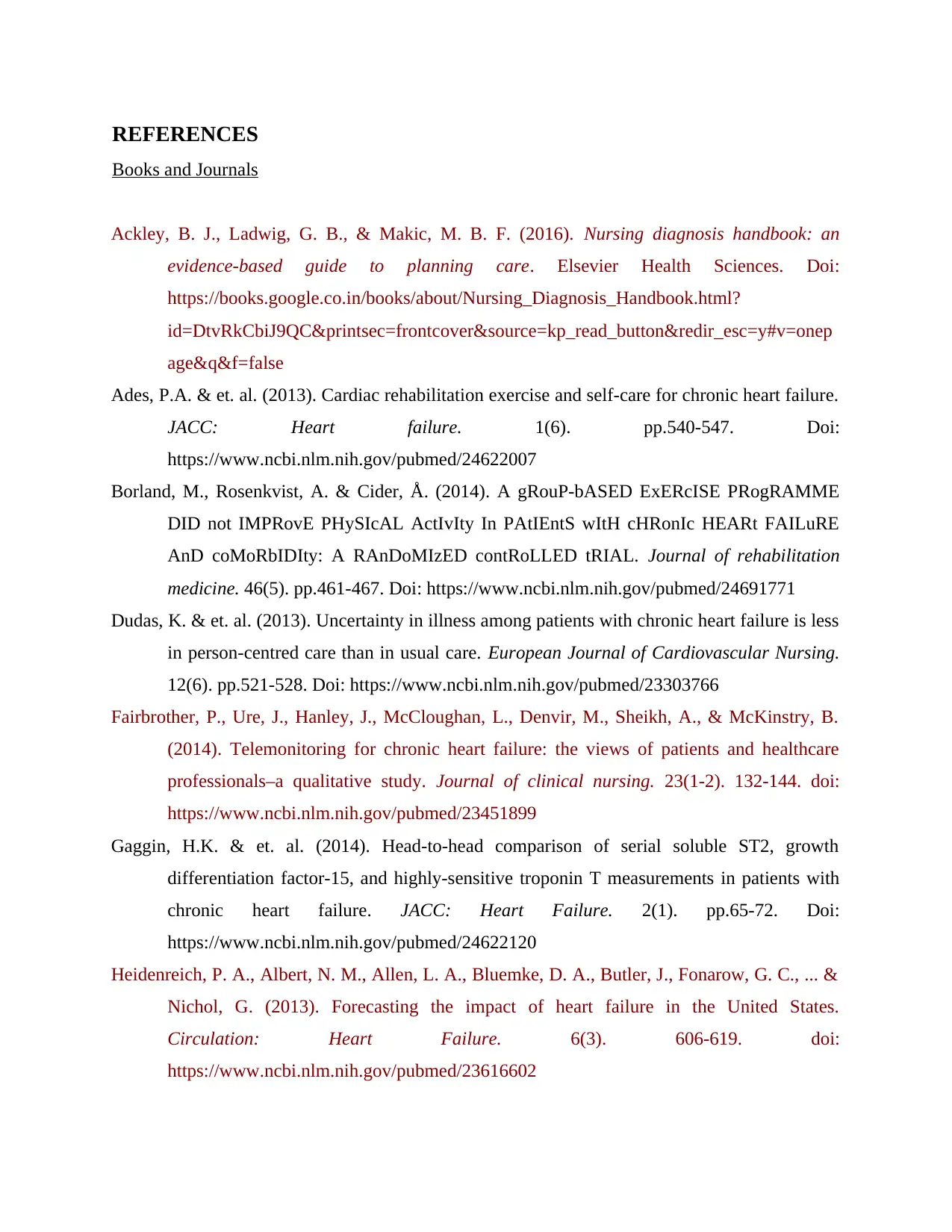
REFERENCES
Books and Journals
Ackley, B. J., Ladwig, G. B., & Makic, M. B. F. (2016). Nursing diagnosis handbook: an
evidence-based guide to planning care. Elsevier Health Sciences. Doi:
https://books.google.co.in/books/about/Nursing_Diagnosis_Handbook.html?
id=DtvRkCbiJ9QC&printsec=frontcover&source=kp_read_button&redir_esc=y#v=onep
age&q&f=false
Ades, P.A. & et. al. (2013). Cardiac rehabilitation exercise and self-care for chronic heart failure.
JACC: Heart failure. 1(6). pp.540-547. Doi:
https://www.ncbi.nlm.nih.gov/pubmed/24622007
Borland, M., Rosenkvist, A. & Cider, Å. (2014). A gRouP-bASED ExERcISE PRogRAMME
DID not IMPRovE PHySIcAL ActIvIty In PAtIEntS wItH cHRonIc HEARt FAILuRE
AnD coMoRbIDIty: A RAnDoMIzED contRoLLED tRIAL. Journal of rehabilitation
medicine. 46(5). pp.461-467. Doi: https://www.ncbi.nlm.nih.gov/pubmed/24691771
Dudas, K. & et. al. (2013). Uncertainty in illness among patients with chronic heart failure is less
in person-centred care than in usual care. European Journal of Cardiovascular Nursing.
12(6). pp.521-528. Doi: https://www.ncbi.nlm.nih.gov/pubmed/23303766
Fairbrother, P., Ure, J., Hanley, J., McCloughan, L., Denvir, M., Sheikh, A., & McKinstry, B.
(2014). Telemonitoring for chronic heart failure: the views of patients and healthcare
professionals–a qualitative study. Journal of clinical nursing. 23(1-2). 132-144. doi:
https://www.ncbi.nlm.nih.gov/pubmed/23451899
Gaggin, H.K. & et. al. (2014). Head-to-head comparison of serial soluble ST2, growth
differentiation factor-15, and highly-sensitive troponin T measurements in patients with
chronic heart failure. JACC: Heart Failure. 2(1). pp.65-72. Doi:
https://www.ncbi.nlm.nih.gov/pubmed/24622120
Heidenreich, P. A., Albert, N. M., Allen, L. A., Bluemke, D. A., Butler, J., Fonarow, G. C., ... &
Nichol, G. (2013). Forecasting the impact of heart failure in the United States.
Circulation: Heart Failure. 6(3). 606-619. doi:
https://www.ncbi.nlm.nih.gov/pubmed/23616602
Books and Journals
Ackley, B. J., Ladwig, G. B., & Makic, M. B. F. (2016). Nursing diagnosis handbook: an
evidence-based guide to planning care. Elsevier Health Sciences. Doi:
https://books.google.co.in/books/about/Nursing_Diagnosis_Handbook.html?
id=DtvRkCbiJ9QC&printsec=frontcover&source=kp_read_button&redir_esc=y#v=onep
age&q&f=false
Ades, P.A. & et. al. (2013). Cardiac rehabilitation exercise and self-care for chronic heart failure.
JACC: Heart failure. 1(6). pp.540-547. Doi:
https://www.ncbi.nlm.nih.gov/pubmed/24622007
Borland, M., Rosenkvist, A. & Cider, Å. (2014). A gRouP-bASED ExERcISE PRogRAMME
DID not IMPRovE PHySIcAL ActIvIty In PAtIEntS wItH cHRonIc HEARt FAILuRE
AnD coMoRbIDIty: A RAnDoMIzED contRoLLED tRIAL. Journal of rehabilitation
medicine. 46(5). pp.461-467. Doi: https://www.ncbi.nlm.nih.gov/pubmed/24691771
Dudas, K. & et. al. (2013). Uncertainty in illness among patients with chronic heart failure is less
in person-centred care than in usual care. European Journal of Cardiovascular Nursing.
12(6). pp.521-528. Doi: https://www.ncbi.nlm.nih.gov/pubmed/23303766
Fairbrother, P., Ure, J., Hanley, J., McCloughan, L., Denvir, M., Sheikh, A., & McKinstry, B.
(2014). Telemonitoring for chronic heart failure: the views of patients and healthcare
professionals–a qualitative study. Journal of clinical nursing. 23(1-2). 132-144. doi:
https://www.ncbi.nlm.nih.gov/pubmed/23451899
Gaggin, H.K. & et. al. (2014). Head-to-head comparison of serial soluble ST2, growth
differentiation factor-15, and highly-sensitive troponin T measurements in patients with
chronic heart failure. JACC: Heart Failure. 2(1). pp.65-72. Doi:
https://www.ncbi.nlm.nih.gov/pubmed/24622120
Heidenreich, P. A., Albert, N. M., Allen, L. A., Bluemke, D. A., Butler, J., Fonarow, G. C., ... &
Nichol, G. (2013). Forecasting the impact of heart failure in the United States.
Circulation: Heart Failure. 6(3). 606-619. doi:
https://www.ncbi.nlm.nih.gov/pubmed/23616602
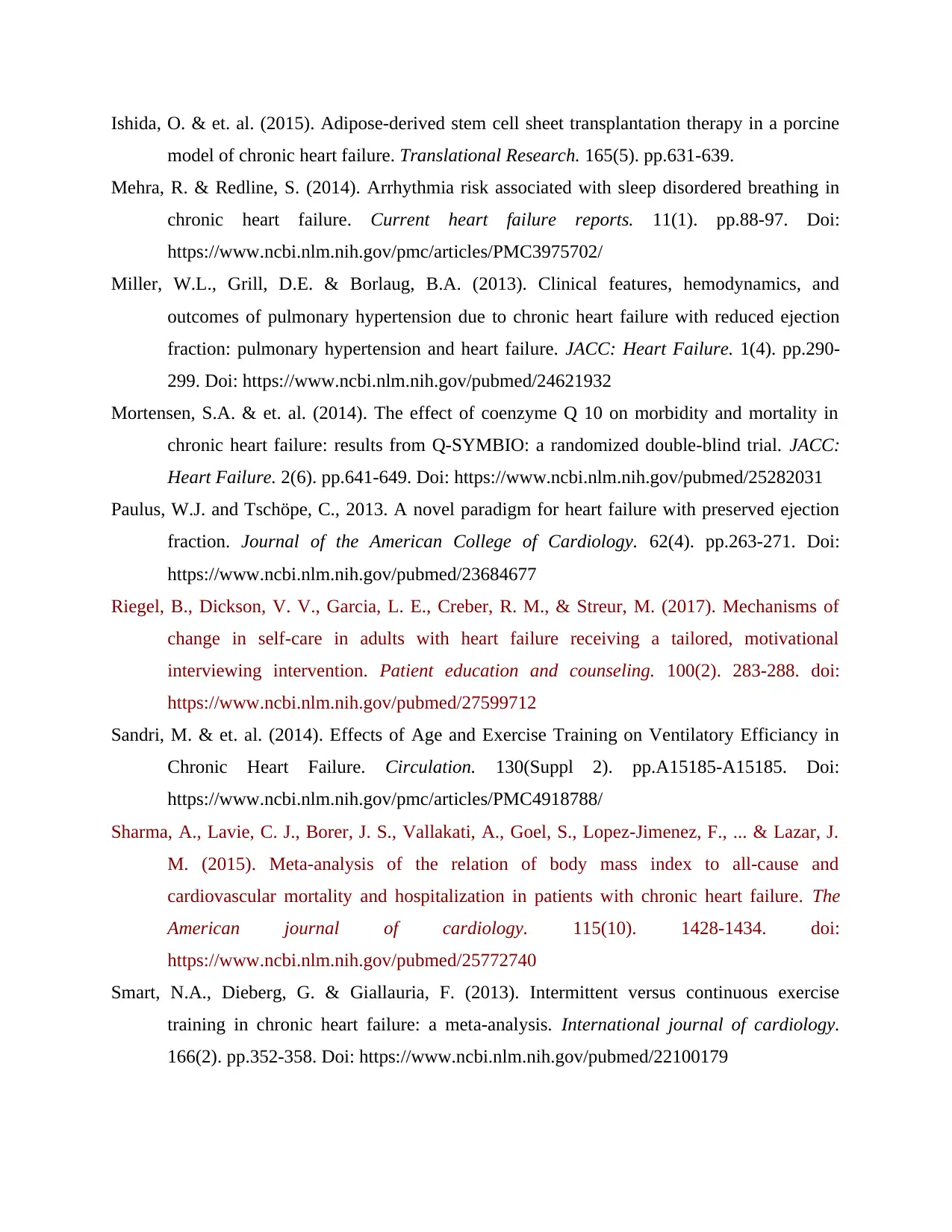
Ishida, O. & et. al. (2015). Adipose-derived stem cell sheet transplantation therapy in a porcine
model of chronic heart failure. Translational Research. 165(5). pp.631-639.
Mehra, R. & Redline, S. (2014). Arrhythmia risk associated with sleep disordered breathing in
chronic heart failure. Current heart failure reports. 11(1). pp.88-97. Doi:
https://www.ncbi.nlm.nih.gov/pmc/articles/PMC3975702/
Miller, W.L., Grill, D.E. & Borlaug, B.A. (2013). Clinical features, hemodynamics, and
outcomes of pulmonary hypertension due to chronic heart failure with reduced ejection
fraction: pulmonary hypertension and heart failure. JACC: Heart Failure. 1(4). pp.290-
299. Doi: https://www.ncbi.nlm.nih.gov/pubmed/24621932
Mortensen, S.A. & et. al. (2014). The effect of coenzyme Q 10 on morbidity and mortality in
chronic heart failure: results from Q-SYMBIO: a randomized double-blind trial. JACC:
Heart Failure. 2(6). pp.641-649. Doi: https://www.ncbi.nlm.nih.gov/pubmed/25282031
Paulus, W.J. and Tschöpe, C., 2013. A novel paradigm for heart failure with preserved ejection
fraction. Journal of the American College of Cardiology. 62(4). pp.263-271. Doi:
https://www.ncbi.nlm.nih.gov/pubmed/23684677
Riegel, B., Dickson, V. V., Garcia, L. E., Creber, R. M., & Streur, M. (2017). Mechanisms of
change in self-care in adults with heart failure receiving a tailored, motivational
interviewing intervention. Patient education and counseling. 100(2). 283-288. doi:
https://www.ncbi.nlm.nih.gov/pubmed/27599712
Sandri, M. & et. al. (2014). Effects of Age and Exercise Training on Ventilatory Efficiancy in
Chronic Heart Failure. Circulation. 130(Suppl 2). pp.A15185-A15185. Doi:
https://www.ncbi.nlm.nih.gov/pmc/articles/PMC4918788/
Sharma, A., Lavie, C. J., Borer, J. S., Vallakati, A., Goel, S., Lopez-Jimenez, F., ... & Lazar, J.
M. (2015). Meta-analysis of the relation of body mass index to all-cause and
cardiovascular mortality and hospitalization in patients with chronic heart failure. The
American journal of cardiology. 115(10). 1428-1434. doi:
https://www.ncbi.nlm.nih.gov/pubmed/25772740
Smart, N.A., Dieberg, G. & Giallauria, F. (2013). Intermittent versus continuous exercise
training in chronic heart failure: a meta-analysis. International journal of cardiology.
166(2). pp.352-358. Doi: https://www.ncbi.nlm.nih.gov/pubmed/22100179
model of chronic heart failure. Translational Research. 165(5). pp.631-639.
Mehra, R. & Redline, S. (2014). Arrhythmia risk associated with sleep disordered breathing in
chronic heart failure. Current heart failure reports. 11(1). pp.88-97. Doi:
https://www.ncbi.nlm.nih.gov/pmc/articles/PMC3975702/
Miller, W.L., Grill, D.E. & Borlaug, B.A. (2013). Clinical features, hemodynamics, and
outcomes of pulmonary hypertension due to chronic heart failure with reduced ejection
fraction: pulmonary hypertension and heart failure. JACC: Heart Failure. 1(4). pp.290-
299. Doi: https://www.ncbi.nlm.nih.gov/pubmed/24621932
Mortensen, S.A. & et. al. (2014). The effect of coenzyme Q 10 on morbidity and mortality in
chronic heart failure: results from Q-SYMBIO: a randomized double-blind trial. JACC:
Heart Failure. 2(6). pp.641-649. Doi: https://www.ncbi.nlm.nih.gov/pubmed/25282031
Paulus, W.J. and Tschöpe, C., 2013. A novel paradigm for heart failure with preserved ejection
fraction. Journal of the American College of Cardiology. 62(4). pp.263-271. Doi:
https://www.ncbi.nlm.nih.gov/pubmed/23684677
Riegel, B., Dickson, V. V., Garcia, L. E., Creber, R. M., & Streur, M. (2017). Mechanisms of
change in self-care in adults with heart failure receiving a tailored, motivational
interviewing intervention. Patient education and counseling. 100(2). 283-288. doi:
https://www.ncbi.nlm.nih.gov/pubmed/27599712
Sandri, M. & et. al. (2014). Effects of Age and Exercise Training on Ventilatory Efficiancy in
Chronic Heart Failure. Circulation. 130(Suppl 2). pp.A15185-A15185. Doi:
https://www.ncbi.nlm.nih.gov/pmc/articles/PMC4918788/
Sharma, A., Lavie, C. J., Borer, J. S., Vallakati, A., Goel, S., Lopez-Jimenez, F., ... & Lazar, J.
M. (2015). Meta-analysis of the relation of body mass index to all-cause and
cardiovascular mortality and hospitalization in patients with chronic heart failure. The
American journal of cardiology. 115(10). 1428-1434. doi:
https://www.ncbi.nlm.nih.gov/pubmed/25772740
Smart, N.A., Dieberg, G. & Giallauria, F. (2013). Intermittent versus continuous exercise
training in chronic heart failure: a meta-analysis. International journal of cardiology.
166(2). pp.352-358. Doi: https://www.ncbi.nlm.nih.gov/pubmed/22100179
⊘ This is a preview!⊘
Do you want full access?
Subscribe today to unlock all pages.

Trusted by 1+ million students worldwide
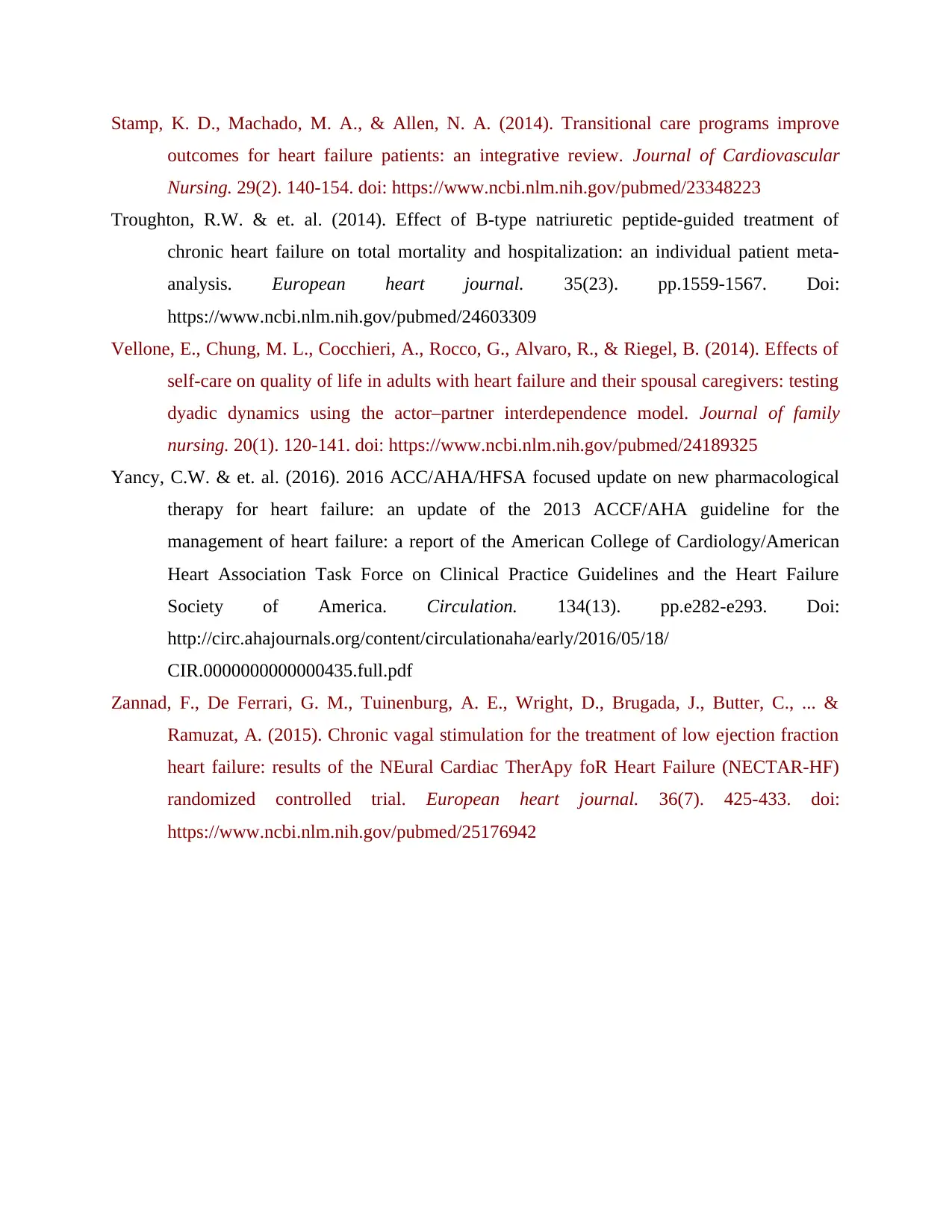
Stamp, K. D., Machado, M. A., & Allen, N. A. (2014). Transitional care programs improve
outcomes for heart failure patients: an integrative review. Journal of Cardiovascular
Nursing. 29(2). 140-154. doi: https://www.ncbi.nlm.nih.gov/pubmed/23348223
Troughton, R.W. & et. al. (2014). Effect of B-type natriuretic peptide-guided treatment of
chronic heart failure on total mortality and hospitalization: an individual patient meta-
analysis. European heart journal. 35(23). pp.1559-1567. Doi:
https://www.ncbi.nlm.nih.gov/pubmed/24603309
Vellone, E., Chung, M. L., Cocchieri, A., Rocco, G., Alvaro, R., & Riegel, B. (2014). Effects of
self-care on quality of life in adults with heart failure and their spousal caregivers: testing
dyadic dynamics using the actor–partner interdependence model. Journal of family
nursing. 20(1). 120-141. doi: https://www.ncbi.nlm.nih.gov/pubmed/24189325
Yancy, C.W. & et. al. (2016). 2016 ACC/AHA/HFSA focused update on new pharmacological
therapy for heart failure: an update of the 2013 ACCF/AHA guideline for the
management of heart failure: a report of the American College of Cardiology/American
Heart Association Task Force on Clinical Practice Guidelines and the Heart Failure
Society of America. Circulation. 134(13). pp.e282-e293. Doi:
http://circ.ahajournals.org/content/circulationaha/early/2016/05/18/
CIR.0000000000000435.full.pdf
Zannad, F., De Ferrari, G. M., Tuinenburg, A. E., Wright, D., Brugada, J., Butter, C., ... &
Ramuzat, A. (2015). Chronic vagal stimulation for the treatment of low ejection fraction
heart failure: results of the NEural Cardiac TherApy foR Heart Failure (NECTAR-HF)
randomized controlled trial. European heart journal. 36(7). 425-433. doi:
https://www.ncbi.nlm.nih.gov/pubmed/25176942
outcomes for heart failure patients: an integrative review. Journal of Cardiovascular
Nursing. 29(2). 140-154. doi: https://www.ncbi.nlm.nih.gov/pubmed/23348223
Troughton, R.W. & et. al. (2014). Effect of B-type natriuretic peptide-guided treatment of
chronic heart failure on total mortality and hospitalization: an individual patient meta-
analysis. European heart journal. 35(23). pp.1559-1567. Doi:
https://www.ncbi.nlm.nih.gov/pubmed/24603309
Vellone, E., Chung, M. L., Cocchieri, A., Rocco, G., Alvaro, R., & Riegel, B. (2014). Effects of
self-care on quality of life in adults with heart failure and their spousal caregivers: testing
dyadic dynamics using the actor–partner interdependence model. Journal of family
nursing. 20(1). 120-141. doi: https://www.ncbi.nlm.nih.gov/pubmed/24189325
Yancy, C.W. & et. al. (2016). 2016 ACC/AHA/HFSA focused update on new pharmacological
therapy for heart failure: an update of the 2013 ACCF/AHA guideline for the
management of heart failure: a report of the American College of Cardiology/American
Heart Association Task Force on Clinical Practice Guidelines and the Heart Failure
Society of America. Circulation. 134(13). pp.e282-e293. Doi:
http://circ.ahajournals.org/content/circulationaha/early/2016/05/18/
CIR.0000000000000435.full.pdf
Zannad, F., De Ferrari, G. M., Tuinenburg, A. E., Wright, D., Brugada, J., Butter, C., ... &
Ramuzat, A. (2015). Chronic vagal stimulation for the treatment of low ejection fraction
heart failure: results of the NEural Cardiac TherApy foR Heart Failure (NECTAR-HF)
randomized controlled trial. European heart journal. 36(7). 425-433. doi:
https://www.ncbi.nlm.nih.gov/pubmed/25176942
Paraphrase This Document
Need a fresh take? Get an instant paraphrase of this document with our AI Paraphraser


⊘ This is a preview!⊘
Do you want full access?
Subscribe today to unlock all pages.

Trusted by 1+ million students worldwide
1 out of 13
Related Documents
Your All-in-One AI-Powered Toolkit for Academic Success.
+13062052269
info@desklib.com
Available 24*7 on WhatsApp / Email
![[object Object]](/_next/static/media/star-bottom.7253800d.svg)
Unlock your academic potential
Copyright © 2020–2025 A2Z Services. All Rights Reserved. Developed and managed by ZUCOL.





